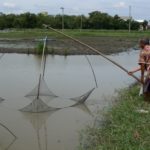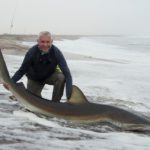The Giant Snakehead fish (Channa micropeltes) is a highly aggressive and predatory freshwater fish. Its diet mainly consists of smaller fish, frogs, crustaceans, and aquatic prey. In Malaysia, Singapore, and Indonesia, this fish is known as the ‘Toman’ and, along with the Hampala Barb (Hampala macrolepidota), it is the most coveted freshwater gamefish in these countries. However, the situation differs in Myanmar, Thailand, Cambodia, and Vietnam. Fishing for sport is only minimally developed in these regions, and most fishing activities are geared towards subsistence purposes.
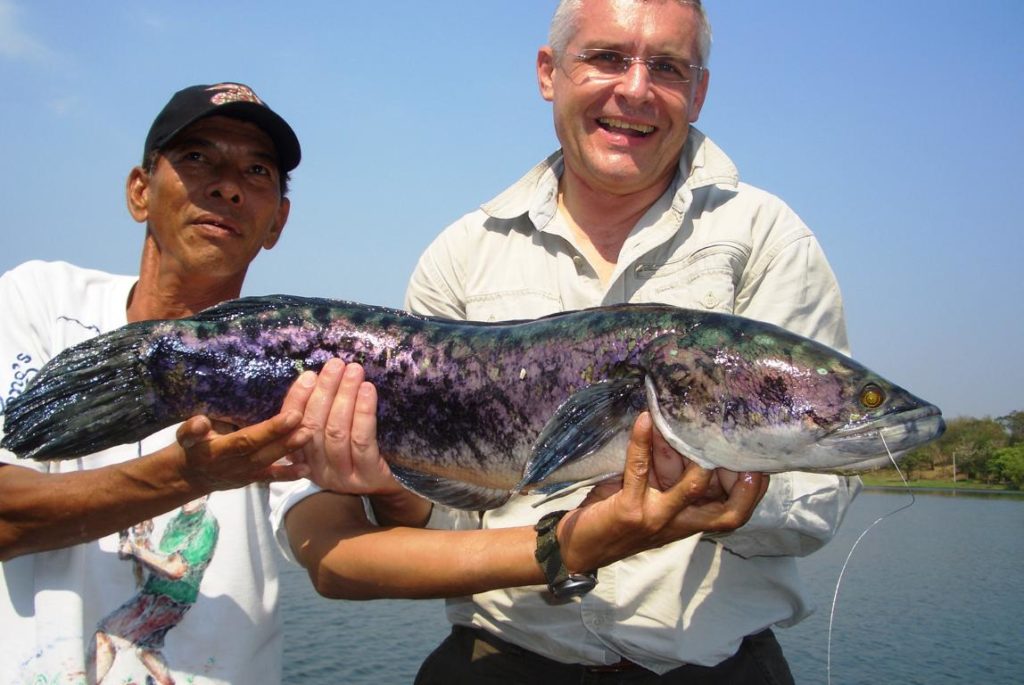
Description
Giant Snakehead fish can grow up to 1.3 meters long and weigh up to 20 kg (44 lbs). They have a long, elongated body with a snakelike appearance. Their coloration typically consists of mottled green on the upper side, purple stripes on the flanks, and a whitish belly. However, a wide range of color variations exist, including individuals with nearly black-and-white blotches. The fish fry exhibits an intense red color, which develops into a two-striped reddish pattern as they mature. For additional information, please refer to this link.
Distribution
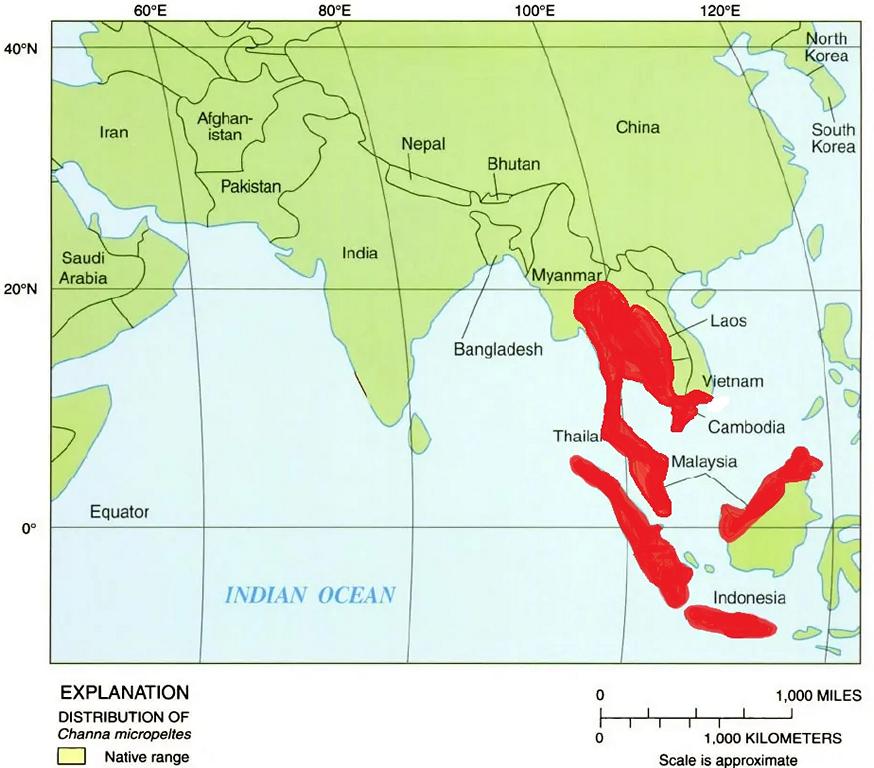
The Giant Snakehead fish (Channa micropeltes) is found in Southeast Asian countries, including Cambodia, Laos, Vietnam, Thailand, Borneo, Sumatra, Java, and Singapore. Interestingly, since 1878, the Malabar snakehead (Ch. diplogramma) was considered synonymous with the Giant Snakehead (Ch. micropeltes). However, in 2011, the Malabar snakehead was recognized as a distinct species endemic to the Indian Subcontinent. Therefore, the distribution of C. micropeltes does not include India.
The abundance of Giant Snakeheads is determined by their distribution range and the densities in which they occur. Particularly in Malaysia, there is a notable population density of Giant Snakeheads in both natural and man-made water bodies. This is primarily due to their high value as a sought-after game fish for sport fishing.
In most other countries where Giant Snakeheads are found, they compete with local fishermen as they prey on other fish species that are popular among humans. Consequently, these fish are extensively caught by any means available and are rarely released back into the water. As a result, Giant Snakeheads are predominantly found in large reservoirs, lakes, fishing ponds, or temple ponds in these countries.
Summary of Giant Snakehead fish behavior
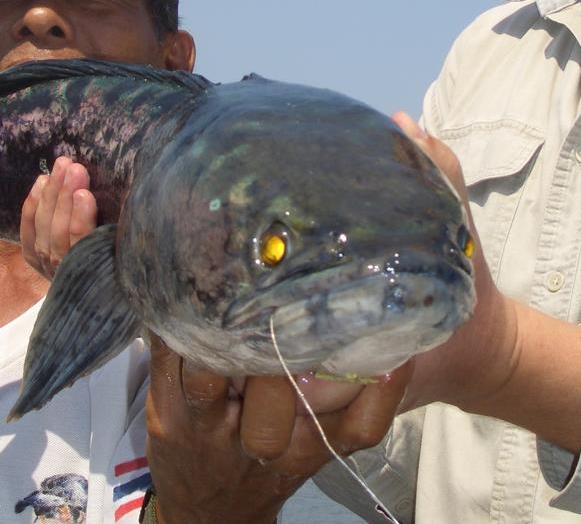
The Giant Snakehead fish displays specific behavioral characteristics. They are typically found in water bodies with slow-moving or stagnant water and possess an accessory breathing organ that allows them to extract oxygen from the air. This adaptation enables them to survive in low-oxygen environments or move overland between different water bodies. They prefer areas with abundant vegetation and structures that provide cover and serve as ambush points. While they can inhabit various depths, Giant Snakehead fish tend to occupy the upper layers of the water column, particularly during their most active periods in the early morning and late afternoon.
These fish exhibit solitary behavior and are highly territorial, fiercely defending their chosen hunting grounds. They display aggression towards intruders or potential threats that enter their territory. Notably, they also exhibit remarkable parental care. During the breeding season, they construct nests in shallow waters, often among vegetation or submerged structures. The parents guard the nest and protect the eggs. After hatching, they diligently safeguard the fry, which typically remain together in a school until the juveniles can independently survive.
Best times to catch them
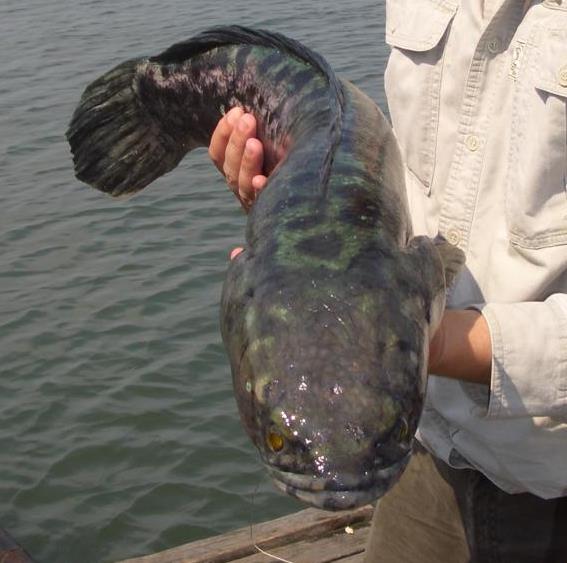
Giant Snakehead fishing can be productive throughout the year, but three seasons offer higher chances of success. In July, following the breeding season, Giant Snakehead fish become more active and aggressive as they search for food to replenish their energy reserves. In August, at the onset of the monsoon season, the water levels rise, water flow increases, and prey is abundant, making it another favorable period for fishing. Additionally, during the breeding season from April to June, adult Channa micropeltes can be easily caught alongside their school of fry. However, it’s important to note that this practice is highly unsustainable for the fish population. Despite this, there is no closed season for spawning or breeding, and it is often carried out by the local population in Thailand.
Standard angling techniques for Giant Snakehead fish
Casting and retrieving lures
This technique for catching Giant Snakehead fish is widely popular. In rural areas of Thailand, where many people practice fishing, water bodies near populated areas are often overfished. Locating untouched areas suitable for lure fishing of Giant Snakeheads can be challenging and typically restricted to remote locations and national parks, accessible only by boat. Hiring a specialized fishing guide for this specific type of fishing is recommended. Simply going there without proper preparation and expecting success is unlikely. Successful fishing requires serious preparation, including the ability to cast long distances. Precise casting is essential, as the fish may be hidden in small areas among lily pads or near structures. Therefore, experienced anglers have an advantage in this pursuit.
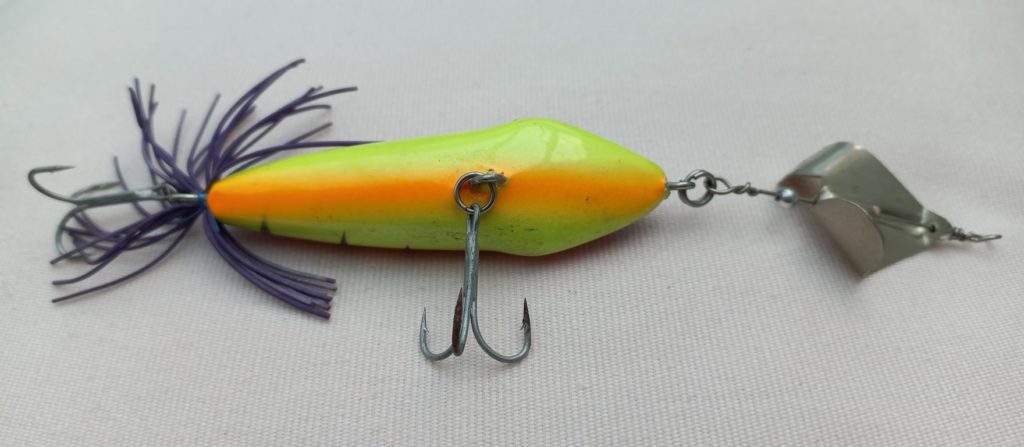

A wide range of lures is suitable for casting, including swimbaits, crankbaits, topwater lures, soft plastic baits, spinnerbaits, and jerk baits. I prefer using poppers and a specific kind of buzz bait as topwater lures, where the propeller is fitted directly in front of the lure. See the picture above. These lures can be cast effectively and create a significant disturbance on the water surface, quickly grabbing these aggressive predators’ attention.
Bottom fishing

Bottom fishing for Giant Snakehead is primarily utilized in lakes and ponds with hard bottom surfaces. It is not suitable for soft and muddy bottoms or areas with dense vegetation. The typical rig for bottom fishing does not involve the use of a float or sinker. Instead, it consists of an inconspicuous tackle, held down by the weight of the bait, and a floating foam disc used as a bite indicator.
Chicken liver is considered the best bait for bottom fishing. It is the appropriate size for attracting large Snakeheads, and its outer membrane is rubbery, helping to keep the liver intact and the hook securely embedded. Over time, the liver releases particles into the water, creating a long-lasting scent trail that entices the fish.
After casting the bait into open water, which should not exceed a depth of 1-2 meters, it sinks to the bottom. It is crucial to ensure no nearby vegetation, as a hooked fish may try to escape into it, and the delicate tackle will not be able to retrieve it.
Unlike fishing techniques that rely on vegetation or structures as strike points, bottom fishing for Giant Snakehead utilizes different principles of attraction, including noise and vibrations, in addition to the enticing scent of the bait.
Attracting Giant snakeheads with noise and vibrations
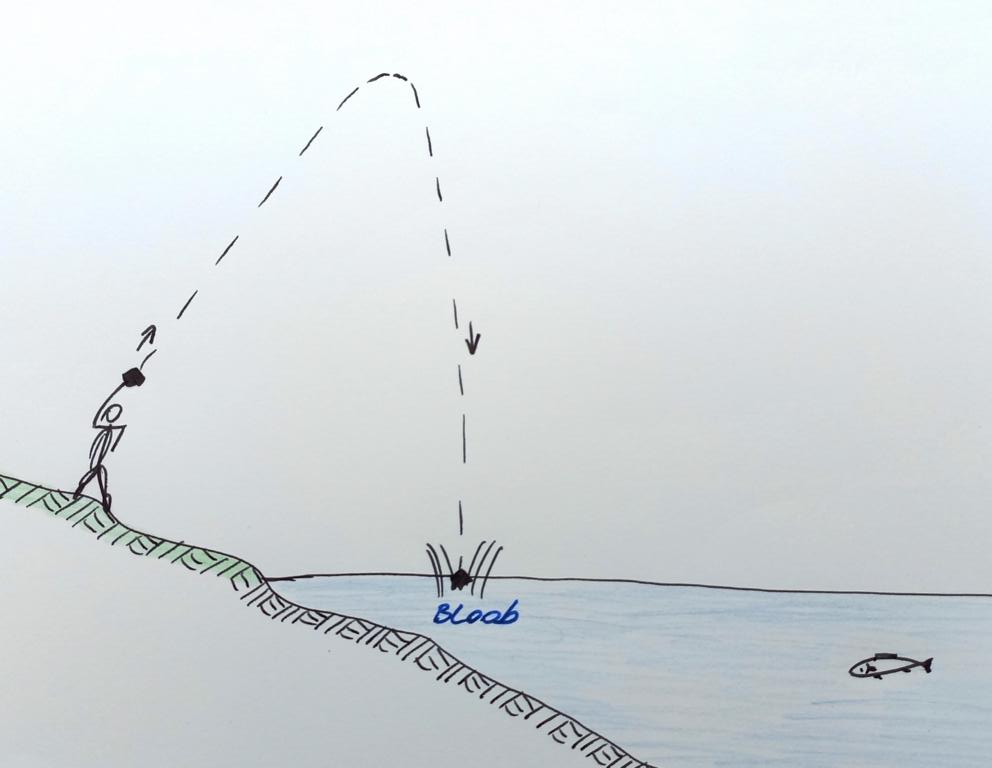
After casting the rig to the desired location, the drag on the reel’s brake should be set to maximum, making it challenging to pull off the line. The reel’s bail is opened, allowing the fish to draw the line freely. The rod can now be placed down, with the tip lowered close to the water surface. There is a possibility of an early strike immediately after casting if a Snakehead happens to be nearby. If not, it is essential to maintain calmness and stillness for at least 15 minutes. Avoid any movements or noises that could scare off the fish.
Throwing a stone
Next, throw a fist-sized or larger stone high into the air near the bait at the water bottom. The stone should fall vertically, creating a distinct ‘Bloob’ noise upon impact. This noise has the characteristic of attracting Snakeheads from a distance.
If the thud attracts a Giant Snakehead and bites the bait, air bubbles will be visible, rising to the water’s surface. The size of these bubbles indicates the size of the Snakehead. Immediately close the reel bail and jerk the rod in the opposite direction of the float’s (foam disc) movement to set the hook firmly. When fighting the fish, it is crucial to keep it away from vegetation or other obstacles that it may use to hide or wrap the line around. Having a large landing net will be advantageous for safely landing the fish.
Once, the author landed a Giant Snakehead fish and promptly released it back into the water. The local bystanders were astonished by what they witnessed. They couldn’t fathom why the ‘Falang’ (a slightly derogatory term for foreigners in Thailand) would let go of such a prized catch. They considered it a waste of potentially abundant fish meat. Additionally, I thought that the Giant Snakehead would resume preying on other fish.
Surface frog fishing
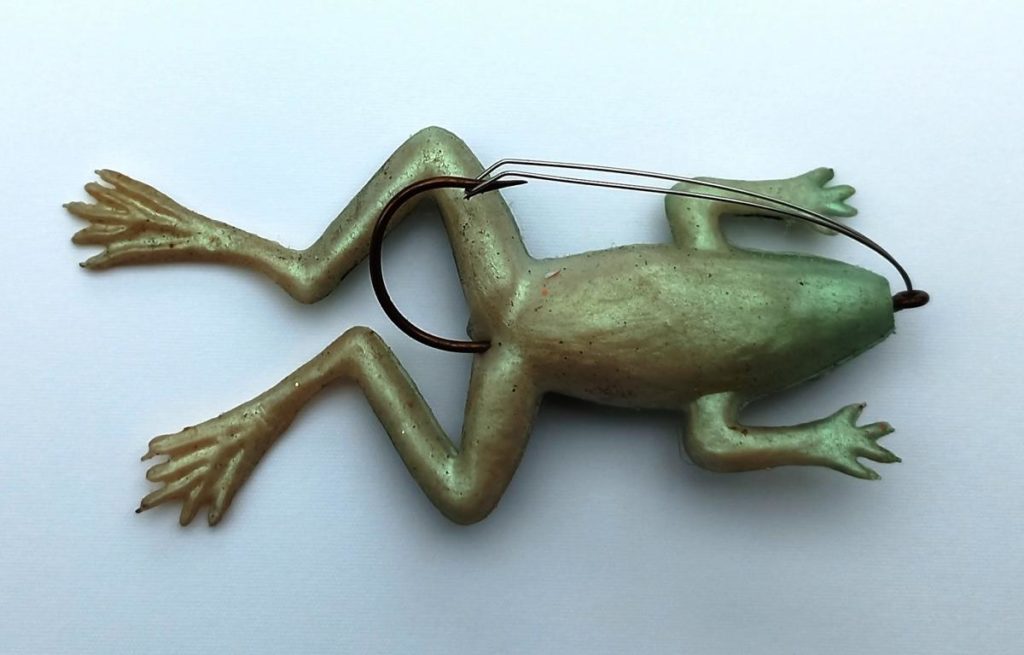
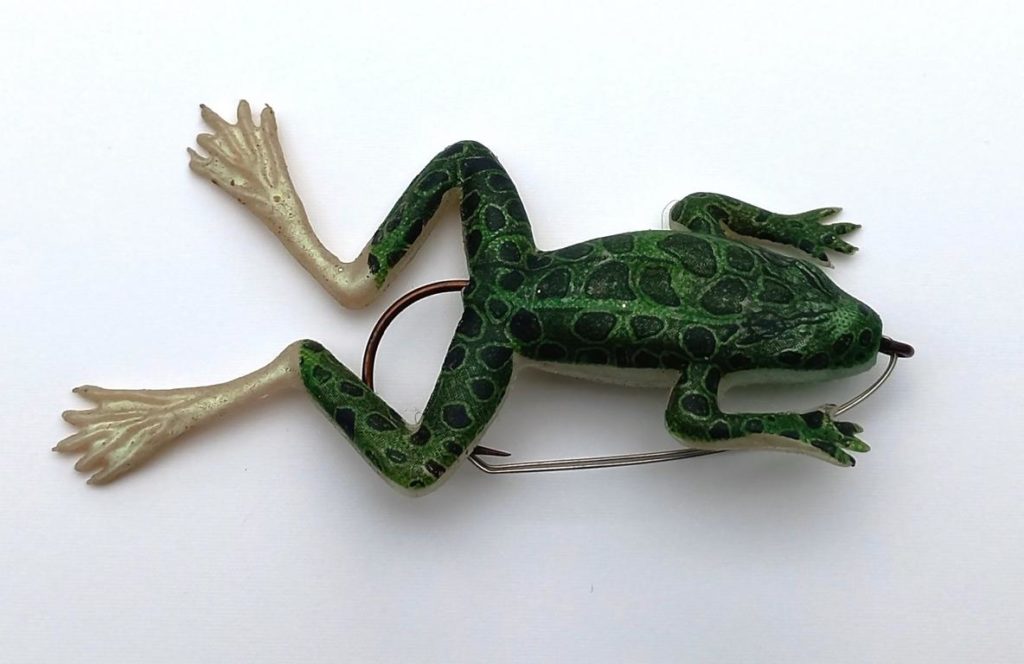
Giant Snakehead fish have a strong inclination towards preying on frogs. Using live or dead frogs as bait can be effective in survival situations. However, it is highly recommended to use soft plastic frogs on #8/0 hooks equipped with a weed clip for recreational fishing. This setup allows the plastic frog lure to be presented through heavily vegetated areas and lily pads without getting snagged. When casting, the frog should be retrieved in a manner that mimics its natural movements as closely as possible. This can be achieved through techniques like ‘Walk-the-dog’ or ‘Pop-and-stop’ actions.
In Thailand, artificial frogs with a propeller in front of the nose are also available. These modified frog lures resemble buzz baits and can be cast behind a school of snakehead fry. By retrieving the lure just above the school of baby fish, the parent fish will perceive it as a threat to their young and will likely strike and get caught.
Other angling techniques for Giant Snakehead
Two additional techniques commonly used for catching Snakeheads with a rod are fly fishing and Live bait fishing. However, I cannot provide personal insights or comment on these techniques as I do not have direct experience with them specifically for targeting Snakehead fish.
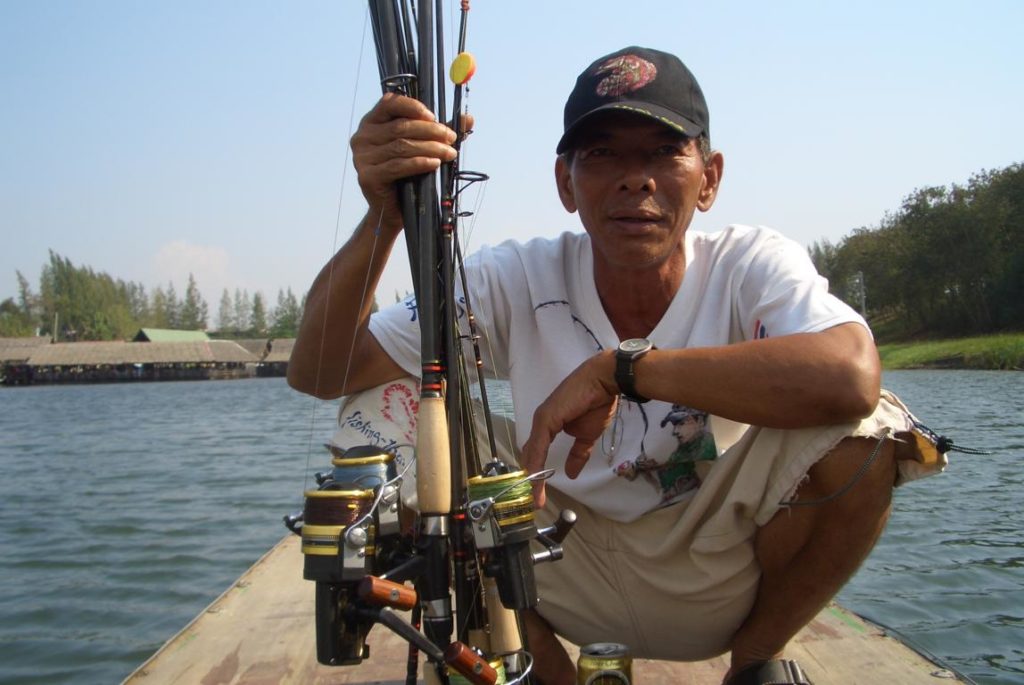
Tackle set-up
When targeting Giant Snakehead fish, the rod, reel, and line choice depends on personal preference and fishing conditions. However, here are some general recommendations:
Rod
A medium-heavy to heavy-action rod with a length of 6 to 7 feet (1.8 to 2.1 meters) is commonly used for Giant Snakehead fishing. This type of rod provides the necessary strength and sensitivity to handle the powerful strikes and fights of the fish while also allowing for good casting distance and accuracy.
Reel
A medium-sized spinning reel with a high line capacity and a robust drag system is suitable for Giant Snakehead fishing. Reels in the size range of 5500 to 6500 are commonly used.
Lines
When targeting Giant Snakehead, it is recommended to use a braided fishing line with a test strength of around 40 pounds (18 kilograms). The braided line provides excellent stability, sensitivity, and abrasion resistance, which are essential when dealing with the fish’s assertive and aggressive nature.
However, if wood or bamboo structures are hidden under the water, it is advisable to use a monofilament line (40 lbs./18 kg) due to its stretching abilities. This can help absorb the shock and prevent the line from breaking when the fish makes sudden runs or dives. A swivel is also recommended for attaching a wire leader between the main line and the hook. The wire leader should have a length of about 3 to 4 feet (0.9 to 1.2 meters) to protect the fish’s sharp teeth.
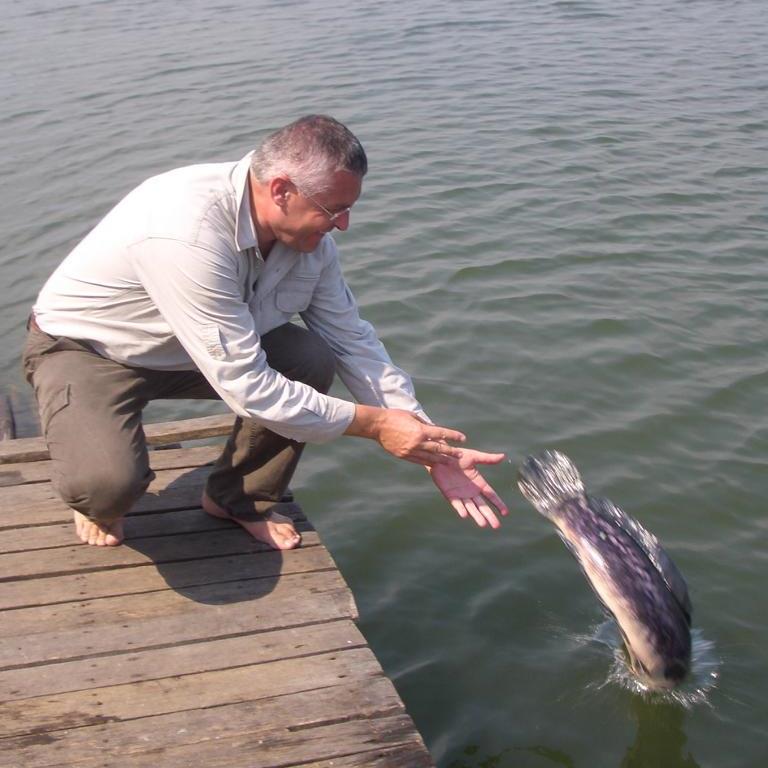
Giant Snakehead as food
Semi-dried and deep-fried
In the Thai language, Giant Snakehead fish are commonly referred to as ‘Pla Chado.’ When preparing these large fish, a preferred method after gutting is to cut the fish lengthwise in the middle, resulting in two slabs. Each slab is then further cut into flaps approximately one hand wide.
In Northern Thailand, these flaps are traditionally salted and sun-dried for three days. During this drying process, the meat changes color, turning into a deep orange hue. It also develops a pronounced sweet taste. After drying, the flaps are deep-fried to create a crispy texture. This preparation method is known for its intense flavor. A picture of this preparation can be seen here.
In Central Thailand, the drying process is typically shorter, lasting only one day. As a result, the taste of the dried fish is less intense compared to the Northern Thai method.
Cooking baby fish
In the past, baby Snakehead fish were also consumed when they formed schools of fry. However, the method of preparing them is really cruel. Local people who enjoyed eating these baby fish would use nets to capture the entire school. After that, they cooked them in a sour and spicy fish soup. This soup was prepared with the main ingredient of Swamp Morning Glory (Ipomoea aquatica). Pictures of this vegetable can be seen in one of my posts here.
In the past, as part of the preparation process, the hollow stems of Morning Glory would be cut into segments and added to a pot of water along with live baby Snakehead fish and seasonings. The pot would then be heated over a fire. As the water temperature increases, the fish instinctively swim into the stems to escape the heat. Once the water reached boiling point, the stems were filled with cooked fish. This cruel cooking technique has become less common, mainly because the snakehead fish have nearly disappeared from natural water sources in Thailand.
Lessons learned from catching a Giant Snakehead fish:
- Giant Snakehead (Channa micropeltes) fish are apex predators in Thai freshwater bodies.
- This species competes with humans for other edible fish, resulting in persecution by most rural villagers.
- The primary fishing methods for Giant Snakeheads include using topwater lures, bottom fishing, and surface fishing with frogs.
- These fish are often cut into hand-sized pieces, dried, and deep-fried for consumption.
- The traditional method of preparing snakehead fish fry considered cruel, is now less commonly practiced by the villagers.
.



